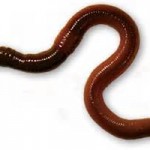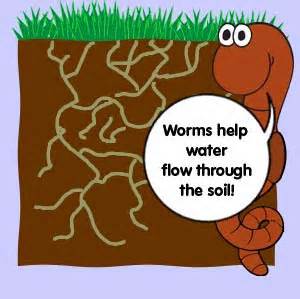“It may be doubted whether there are many other animals which have played so important a part in the history of the world as have these lowly organized creatures.” Charles Darwin
When we celebrate “Earth Day”, we should be talking more about the precious few inches of earth that supports all life here by providing our food. “Healthy Soils, Healthy Plants, Healthy People” is becoming a popular new slogan around the world. This is why our planting soils, fertilizers, seminars, and emails at Canterbury Creek Gardens focus on improving our health by improving our topsoil.
Past civilizations and previous generations have learned how important it is to nourish our topsoil — although many extinct civilizations learned the hard way. Unfortunately, our country has failed to honor the lessons of the “Dust Bowl” years — and we have abandoned measures like resting fields and planting cover crops to let the soil repair itself. We are beginning to realize that the failed agricultural experiments of the last few decades have put America’s rich farmlands into a downward spiral of nutrient depletion and desertification that needs to be reversed.
One of the damaging results of chemical farming — and chemical gardening — and chemical lawn care — is the dramatic reduction of the earthworm population that my generation has witnessed — along with the honeybees. But who cares about some dead worms, what difference does it make?
Here are a few of the benefits that earthworms play in healthy soil that are lost with chemical agricultural methods — some food for thought for “Earth Day”.
The earthworm is irreplaceable in keeping the soil structure open. The tunnels they create are channels that allow the soil to absorb more moisture as water slowly drains through them. The same system allows the water to eventually drain into the subsoil and it brings needed air to the roots and soil microbes. Permaculture co-founder Bill Mollison says that by sliding through their tunnels, earthworms “act as an army of pistons pumping air in and out of the soils”.
Biological improvements to soil
Earthworms also bring life to the soil and are sometimes known as microbe farmers. They turn dirt into a living ecosystem that fully provides for plants.
They pull larger pieces of organic matter, such as leaves or manure found on the soil surface, down into the soil. They also bring up mineral rich soil from the deeper subsoil which naturally helps to replace trace minerals used by plants. In their burrows, the worms will shred the leaves and partially digest them. As organic matter passes through their intestines, it is ground up, mixed with the subsoil minerals they have also ingested, and inoculated with microorganisms.
Although earthworms feed on soil microbes found on decaying organic particles, worm casts (feces) contain more humus and more microbes than the surrounding soil because of the beneficial effect of mixing in their gizzards (or stomachs). The combination of small bits of organic matter, subsoil minerals, and intestinal secretions are ground up in their gizzards and mixed together making an ideal food mix for soil microbes. “In the body of the earthworm we find a complete, high-speed humus factory combining all the processes — both mechanical and chemical — for turning out a finished product containing in rich proportion and in water-soluble form, all the elements required of the earth for plant nutrition. Thomas J. Barrett, “Harnessing The Earthworm” 1947 with several reprints.
Their channels make it easier for roots to penetrate further into the soil and the nutrient and microbe rich casts which line their tunnels help feed the roots. Earthworm casts are 5 times richer in available nitrogen, 7 times richer in available phosphates and 11 times richer in available potassium than the surrounding soil.
Earthworms improve water quality
Earthworm tunnels help prevent water pollution by minimizing runoff, erosion, and chemical transport to waterways. They improve water filtration because their shredding, mixing, and defecating enhances soil biological activity. As water slowly travels through their tunnels, this biological activity can also decompose and filter pollutants before they get into our waterways. Wormless, compacted soils cause water that is carrying pollutants to quickly run off the soil surface and into our waterways without any benefits of microbial decomposition.
Causes of earthworm decline
The application of chemical fertilizers, sprays and dusts have a disastrous effect on earthworm populations. Chemically derived fertilizers tend to create acidic conditions, which are fatal to the worms, and often dead specimens are to be found on the surface following the application of chemical substances. In Australia, changes in farming practices such as the application of superphosphates on pastures and a switch from pastoral farming to arable farming had a devastating effect on populations of the Giant Gippsland earthworm leading to their classification as a protected species.
Encouraging earthworms
 The best way to maintain or increase the levels of worm population in the soil is to avoid the application of chemical fertilizers and pesticides. Adding organic matter like manure, compost, grass clippings, and leaf products on a regular basis will provide them with their food and nutrient requirements. Organic mulches (but not shredded wood products) also provide food and create optimum temperature conditions (cooler in summer and warmer in winter) and moisture to stimulate their activity.
The best way to maintain or increase the levels of worm population in the soil is to avoid the application of chemical fertilizers and pesticides. Adding organic matter like manure, compost, grass clippings, and leaf products on a regular basis will provide them with their food and nutrient requirements. Organic mulches (but not shredded wood products) also provide food and create optimum temperature conditions (cooler in summer and warmer in winter) and moisture to stimulate their activity.
Simply buying earthworms is not a very good use of money or your time. If your soil provides an environment they like, they will show up in appropriate numbers. If you soil does not provide them with a good environment, they will quickly move away, or die out.
Recent research from Rothamsted Experimental Station has produced figures suggesting that rich fertile soil may have up to 432 earthworms per meter². This means that the weight of earthworms beneath a farmer’s soil could be greater than that of the livestock upon its surface.
We often find dozens of worms in a single pot when we recycle our used potting soil through our compost system. Sadly, this is probably more than some 4-step lawn care customers have in their entire yard.
The Costs of Earthworm Decline
The results of low earthworm populations is more money spent on aeration (which is a very poor substitute for worm tunnels), more money spent on dethatching (which removes the nutrients instead of recycling them), more money spent on fertilizing, more money spent on watering (we haven’t watered our lawn in 3 years), more money spent on water purification, and more money spent on pesticides to protect an unhealthy lawn (not to mention the health problems associated with these products). On the farm or in the garden, it also means food that is less nutritious and farm soils that now yield less than 5 or 10 years ago.
Those are some of the reasons why we should worry about a few dead worms.
Build an Earthworm Haven
You can easily build a worm haven in your yard by following a few worm do’s and worm don’ts.
|
Worm Do’s |
|
Worm Don’ts |
|
Manure based, trace mineral enhanced, organic fertilizers are best for worms. |
Avoid chemical fertilizers and pesticides and fertilizers containing GMO products like corn gluten and soy meal. |
|
|
Fresh, living, compost based soil products will seed your yard with beneficial microbes that feed the worms. |
Avoid pre-bagged compost products and peat based soil products that have little microbial life. |
|
|
The best mulches for worms are shredded leaves and shredded bark. |
Avoid mulches made from shredded wood and dyed shredded wood products. |
|
|
Leave on grass clippings to feed the worms. |
||
|
Leave soil undisturbed as much as possible, try cover crops and living mulches. |
Do not till your soil any more than necessary. |

